In an earlier post I mentioned that there is never just one way to grow bonsai. There are many different approaches that I use. In this post I’m hoping to present several different options for a tree like this. All of the different options would yield good bonsai. There’s never a single ‘right’ way to bonsai.
Here is another small, pot grown trident maple with lots of different possibilities.
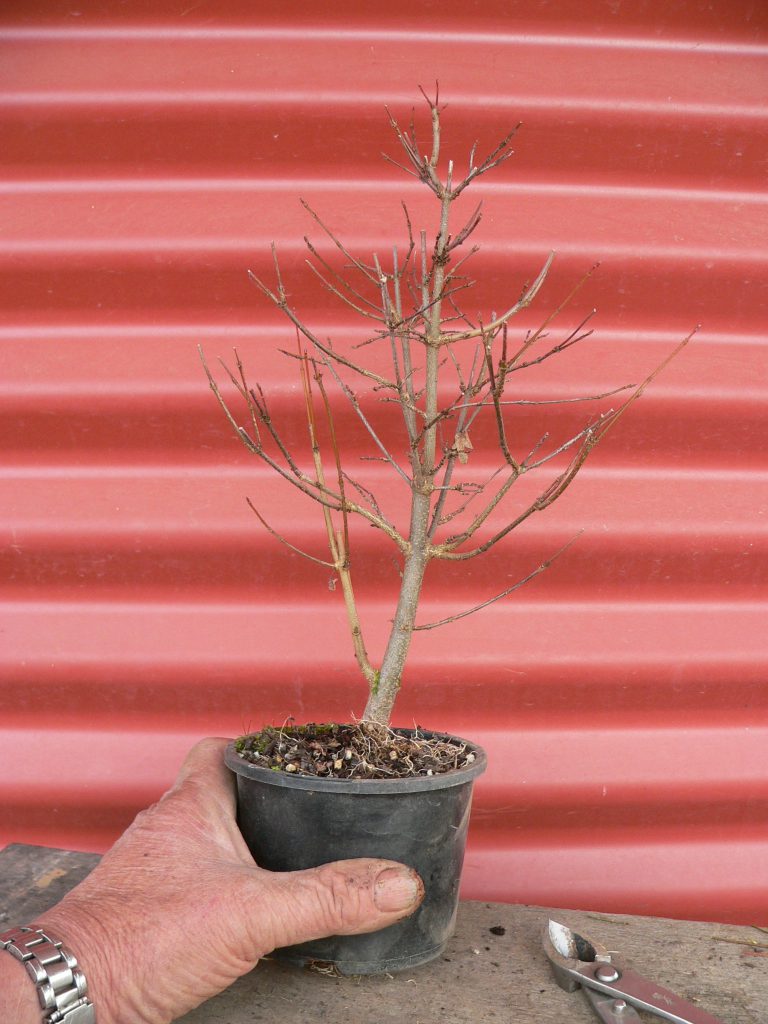
Some beginners would be happy just to put a tree like this straight into a bonsai pot and call it bonsai. It has a trunk and some branches and it does look quite tree like but I can see future possibilities.
First step is always to check the roots. Visible surface roots (nebari) is very important in bonsai, especially in maple bonsai. Visible roots is a sign of age and stability. As trees grow the roots also expand so eventually the roots just under the surface start to get thick enough to show through the ground near the trunk. When we see this our mind knows that must be an old tree. Roots spreading in all directions give us the impression of stability and permanence so good surface roots helps make an impressive bonsai.
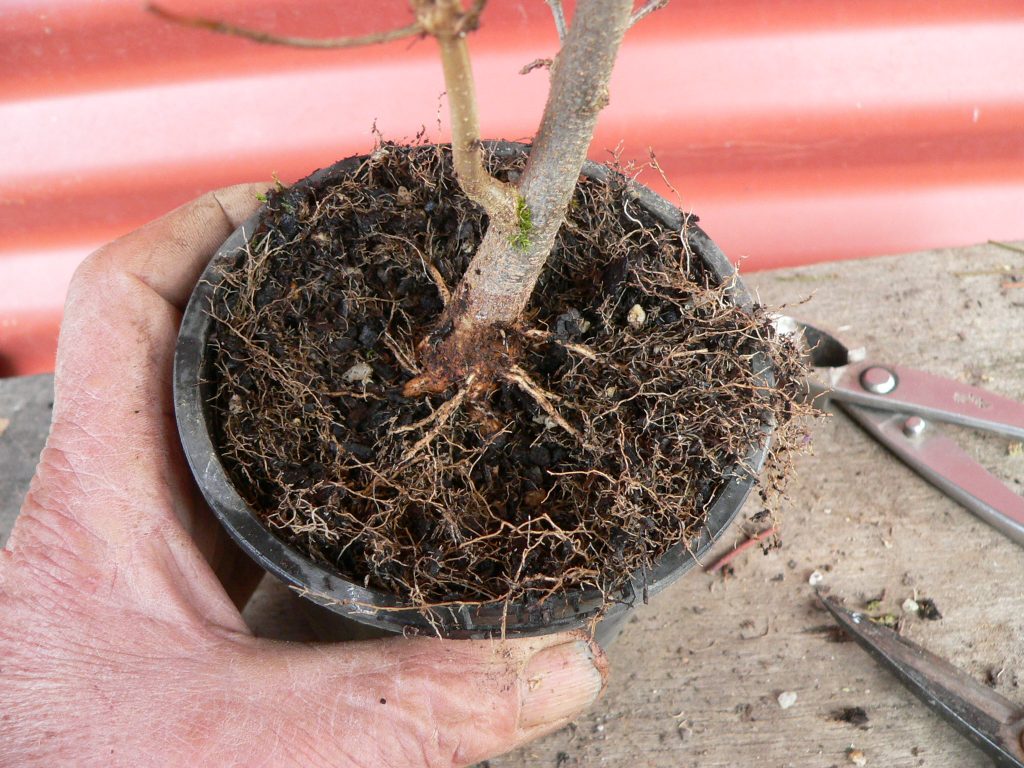
There is a good spread of larger roots there because this tree has already had its roots pruned a couple of times in past years to help form a spreading root system. You may also be able to see some thinner new roots that have grown this past season. They are a little higher than the older roots and mostly on one side of the trunk. If I wanted to lean this trunk over a bit further some of those new, higher roots would be great but I think the current trunk angle is good so I’m going to cut them off and use the existing thicker roots for the nebari on this one. The size, spread and angle of the surface roots is an important factor in deciding how to shape a tree. always check where the roots are and what the look like before starting on design.
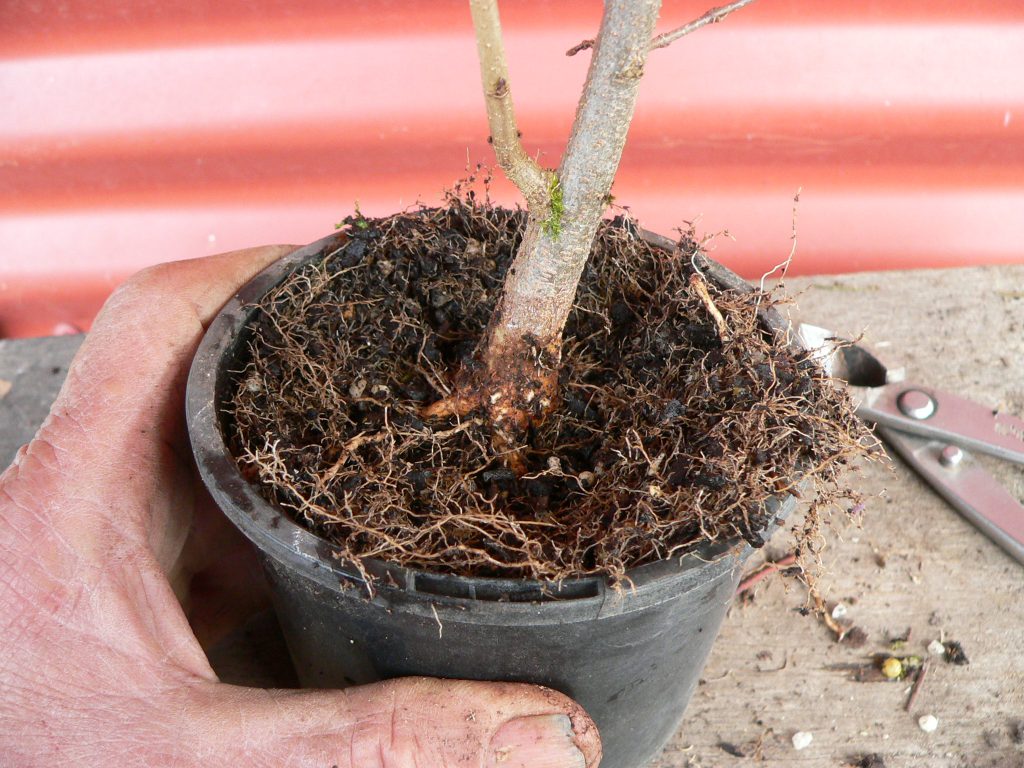
Now we know the roots are Ok let’s check the top.
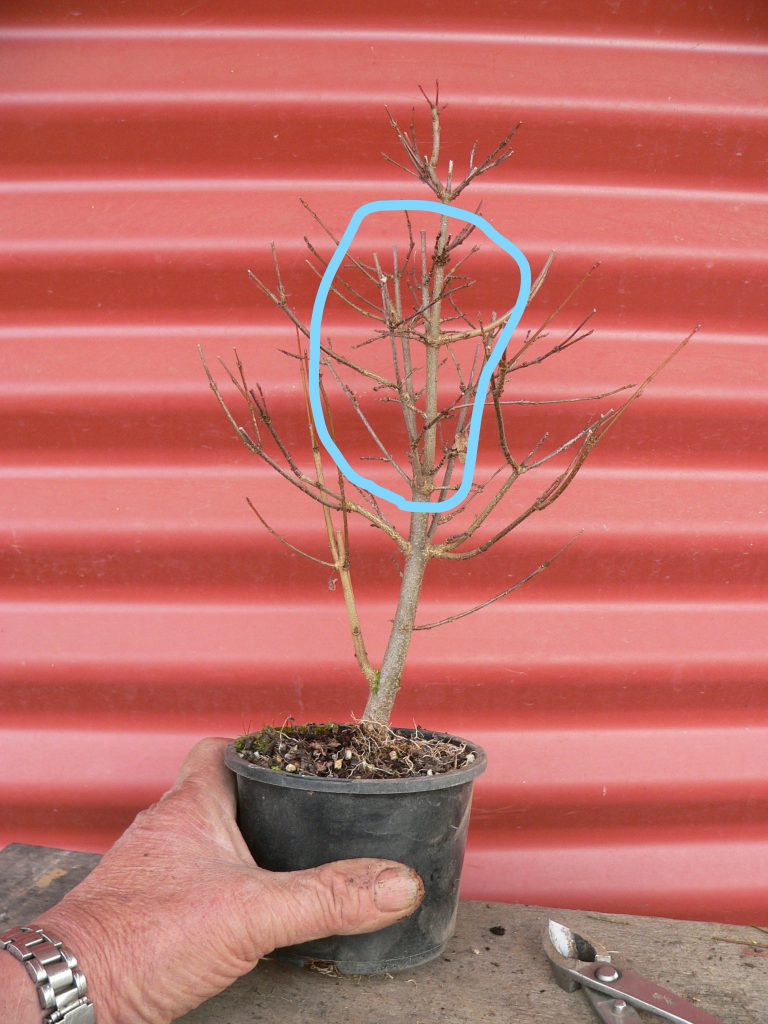
There are 3 strong, vertical leaders on this trunk. Maybe if I wanted to design a broom style tree I could keep several sub-trunks growing from the same place but leaving more than one growing close together will almost certainly lead to the trunk thickening significantly where they join. I try to remove multiples as soon as possible to keep good flowing taper.
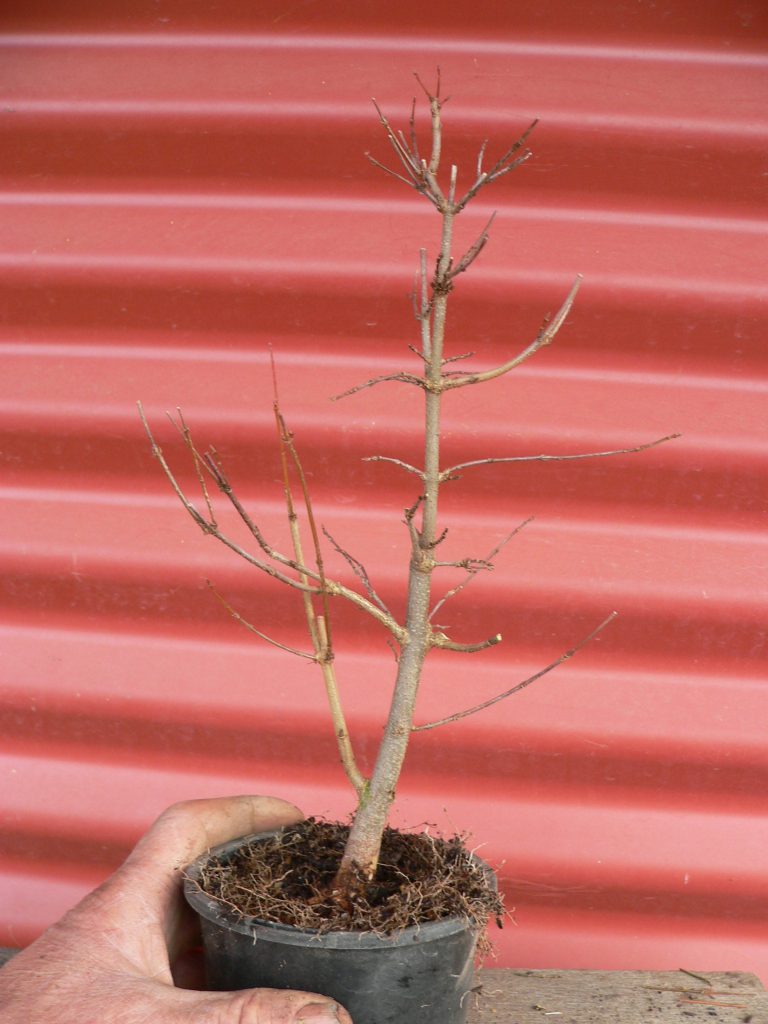
That’s better but the tree now looks very tall and skinny. There’s lots of straight sections which seems a bit boring and there’s very little taper in the trunk. Taper is another important feature to give the impression of an older tree. Young trees grow up quickly to try to reach full height ahead of any competitors. At that stage they are tall and skinny and we recognise them as younger trees. As trees age the trunk becomes fatter but height doesn’t increase much and we tend to recognise that fatter trunks are older trees. In bonsai, we have several options to show viewers thick, old trunks. We can put the tree aside until it does have a thick trunk but we can also change the perspective. A shorter tree with the same sized trunk appears to be fatter than the same tree tall. I’m going to shorten this trident to give it the appearance of thicker trunk.
I usually look for a side branch to cut back to when pruning trees for bonsai. Here’s one option. Note that I’ve chosen a branch that’s growing back toward the base of the tree so I can eventually form more attractive bends in the trunk. This spot also gives me a side branch to start working with. What may seem to be a step backward is actually a bonsai step forward in the future development of this tree.
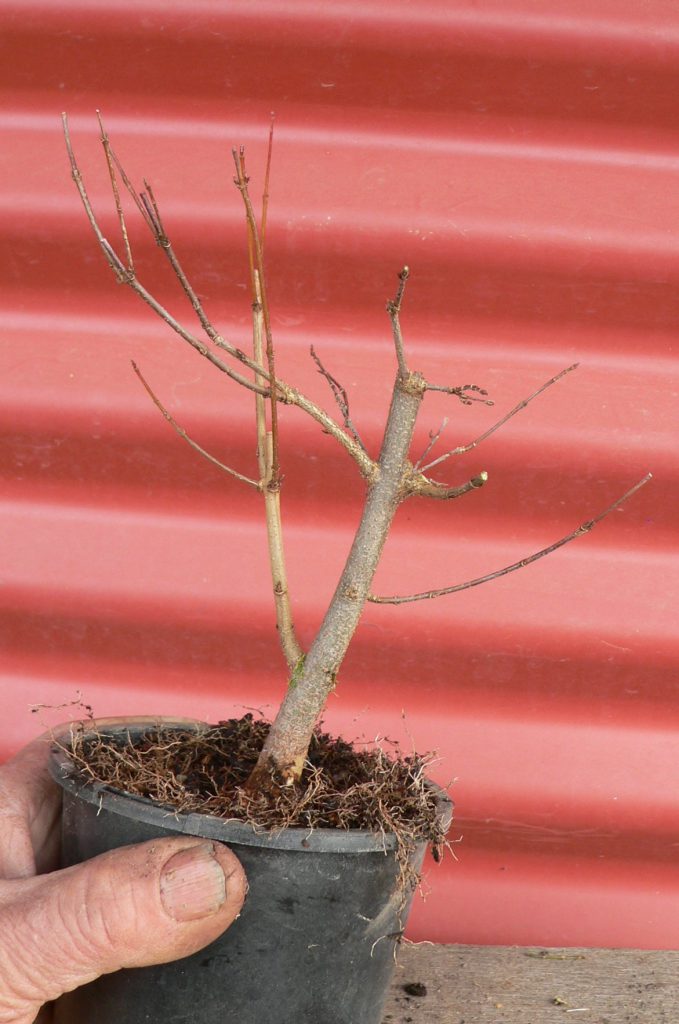
Although the new tree does look a little thicker with that reduction in height I’m still not happy with the result so I’m going to cut lower again.
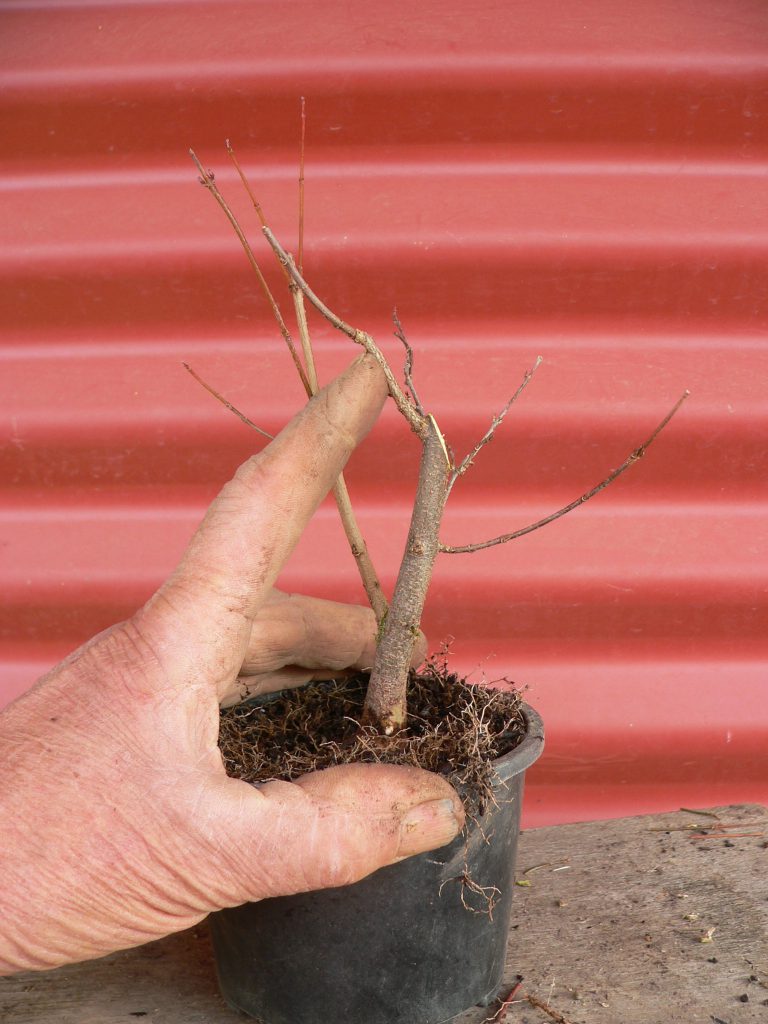
Another temporary bonsai step backward in an attempt to give this tree a better future. This would be a fine spot to stop for now. Wiring that side branch up to become the new trunk gives me a really nice first curve to the future trunk. The step down in size gives the tree far better taper. Taper is another important aspect in simulating older looking trees. As trees age the lower parts tend to thicken far more than the upper parts so we see older trees with thicker trunks and thinner upper branches – taper. There is probably also an element of perspective involved. When we are at ground level, the trunk is close so it appears larger while upper branches are further away and therefore appear thinner due to perspective. Bonsai with good taper definitely appear to be older. Smoother transition from thicker to thin also helps our eyes travel up the trunk when viewing a tree so we try to avoid bulges and reverse taper in bonsai to enhance our view of the trunk and branches.
You might have noticed that I don’t have a desirable branch at that new bend in the trunk. Why didn’t I just chop the main trunk out and leave the new leader and the side branch? Whenever I’ve tried that the results are far from pleasing. The trunk appears to be a thick stump at the cut site. The problem just seems to get worse as the tree continues to grow and thicken. I’ve found this sort of angled cut a far better alternative. But what about a side branch at that bend? Even though there’s nothing there at the moment I know trident maples well enough to be confident that a number of new buds will grow near that cut. One of them will surely give me the branch I need. Another step back to set the stage for a better future.
However, I’m not finished with this tree yet. this option is Ok. It has reasonable taper and a good bend about 10 cm above the roots. With the oft quoted scale of the first branch about 1/3 of the at up a tree to look balance this little tree would probably grow into a really nice 30-40 cm tall bonsai. If that was my aim I’d put this tree aside now, pot it up into a larger pot and allow it to grow freely for another year to increase the trunk thickness.
That lower sub trunk has given me another option for this tree. I can see another step backward that will possibly give me an even better, smaller bonsai some time in the years to come.

This cut has given me even more powerful taper and a bend just 3cm above the roots. With this I will be able to develop a shohin sized bonsai 10-20 cm tall with excellent taper and good trunk bends. As a bonus, the new leader is already heading in the right direction so there’s no need to wire it at this stage. note that I’ve pruned back the new leader to where there’s a couple of sets of buds on short internodes. Short internodes are even more vital for smaller sized bonsai so I always remove shoots with long internodes and develop my trees from shoots and branches with short internodes. The shorter the better.
This tree will be root pruned quite hard this winter or spring to further enhance those surface roots and given fresh potting mix to accelerate growth next summer. A larger pot would give increased growth but there’s a chance of it growing too much and losing the current good points. Slower development takes longer but usually gives me superior results in the end.
